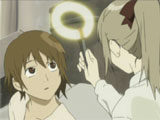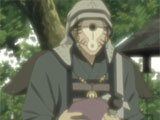

Quick Links:
Haibane Renmei
Haibane Renmei is a slice-of-life series by Yoshitoshi Abe (the character designer for Serial Experiments Lain). The series is pretty low-key, or so one might believe after the first few episodes. But beneath its humble facade lies a powerful message that probably surprised Abe himself as production came to a close. It is a tale of companionship, of giving and forgiving, and perhaps most importantly, the worth of the human soul.
The Haibane* are beings that look like angels, complete with wings and halo. We are introduced to their world through the birth of their newest member, Rakka, and learn along with her about the world she's been born into. Even from the beginning, everything about them seems strange and different; how they are born, how they get their names, how they dress...everything. It's a bit of a culture shock for us and the new girl.
The series is set in Glie**, a small town isolated from the outside world by a massive wall. The town is home to a number of humans and the Haibane. The walls exist to protect the Haibane from whatever it is that's on the other side, and the humans provide the Haibane with jobs, food, and second-hand clothing. Aside from the Haibane and humans, there are the Touga, who facilitate trade between the town and the outside world (and are the only ones allowed to leave the town), and the Haibane Renmei, an organization who are a sort of sponsor for the Haibane.
The first half of the series gets the audience and Rakka acquainted with the other Haibane and their jobs, as well as illuminate the constraints by which the townspeople and Haibane live. This part moves nice and slowly, not only to let the audience enjoy getting to know the characters, but also to invite curiosity about the town and the strict rules the Haibane must follow.
The second half switches gears to address the questions, and eventually reveals the Haibane raison d'etre. The change is triggered by an event called the Day of Flight, which is when a Haibane leaves the town by ascending over the wall, never to return. The event is jarring for Rakka in particular. She is confused and hurt that her friend left, and begins to question everything around her. At this point, the series takes the audience on a spiritual journey.
Abe's storytelling is brilliant in this part. As the characters suffer frustration in coming to terms with their existence, the answers they seek are slowly revealed to them. Below the surface, the story is tackling difficult ideas of religion, such as forgiveness, salvation, and the meaning of life. This is heavy, heavy stuff, but the series makes it accessible through thoughtful dialogue, and takes pauses at convenient times for reflection. I have watched many animations over the years, but I have never before seen one handle spiritual ideas so effectively as this one. It's an incredible experience.
Haibane Renmei's artistic value is almost as great as its literary value. The concept art for the Haibane is gorgeous, using flat shades and yet evoking an aura of brightness. The art for the town and most background scenes is similar, utilizing a lot of browns, grays, and greens, to maintain a mood of tranquil monotony. The purpose of using the more "boring" colors is of course to make us notice with our senses when something changes.
The music serves to smooth out those transitions, and to accent the spiritual moments of the series. Mr. Kou Otani did the score for Haibane, which uses strings and piano heavily. The music is not atmospheric, but instead follows the moods of the characters - yet another element bringing the characters closer to the viewer.
Perhaps what is most special about Haibane Renmei is that it does more than offer food for thought. It provokes thought on what we know in our hearts as the most important things in life, without so much as a word of institutional dogma. I don't know about you, but I think that's impressive. As a last comment, don't let yourself be scared off by the religious topics presented in the show. They stem from Abe's personal beliefs (or so he says), instead of an organization's, and are presented as facets of the characters' quests for identity. I think anybody can get something positive out of this series. Don't miss it for the world!
*"Haibane" literally means, "ash feathers." Though the animation doesn't show it as well, the concept art shows the wings of the Haibane as being a pretty ash gray. The color of the wings is an important theme in the series, symbolizing the fact that the Haibane are neither righteous nor wicked. As an interesting side note, the creators chose "charcoal feathers" as the English equivalent. Charcoal does not carry the same connotations as ash, so one must wonder how they arrived at such a translation.
**La Glie is the French word for glilial cells (cells that are found in the gap between neurons in the brain, also known as a synapse). The name of the town probably wasn't meant to allude to anything, though. I just thought you'd find it interesting. The town itself is inspired by Hard-Boiled Wonderland and the End of the World, a novel by Haruki Murakami. In the novel, the town is described much like what is seen in Haibane Renmei, but there are no Haibane; only beasts with golden coats and horns. The Haibane are Abe's creation, and the beasts do not appear in the show. The book is excellent, by the way. Read it!
Distributor: Geneon Entertainment Creator: Yoshitoshi Abe / Radix Released: 2002
Plot: A+ Character Design: A+ Animation Quality: A Music: A Overall: A+



